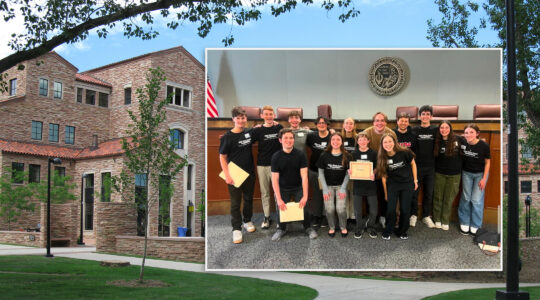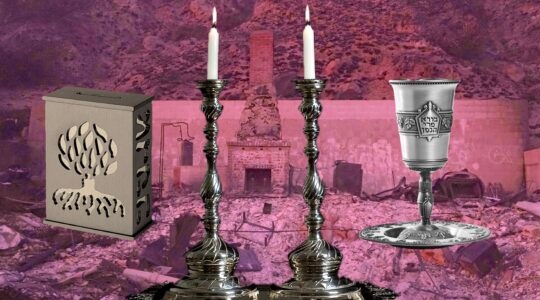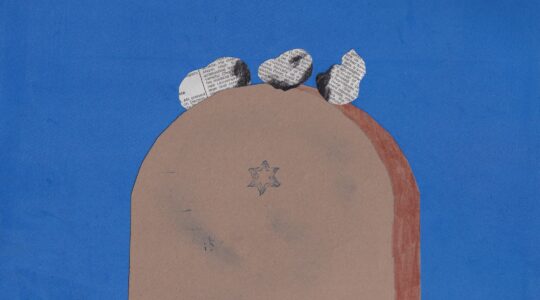Los Angeles — Anne Frank is the most universally known of the six million Jewish victims of the Holocaust.
Her diary has been read by millions of people around the world, and her tragic story of living in fear, hiding from the Nazis in a secret annex in Amsterdam with her family and others for more than two years, has been told in a Broadway play, Hollywood movie, television dramas and in countless other ways. Is there anything more to be known about this precocious young girl with a gift for writing, a poignant faith in humanity, and maturity far beyond her years?
Until now I thought not, having been deeply affected by her diary when I read it as a teenager, as so many others still do, and having imagined the terror she felt on being discovered by the Nazis.
But on visiting the major Anne Frank exhibit at the Simon Wiesenthal Center’s Museum of Tolerance here last week — it opened in October and will remain in place for 10 years — I came away with a deeper understanding of Anne’s story as both an intimate personal tragedy and one that provides historical context in understanding how Hitler’s hatred of Jews could dehumanize a people and lead to their decimation.
Our guide, Matthew Boger, explained at the outset of our tour that the intention of the museum was not to make Anne “a poster child of the Holocaust,” but rather to tell her unique story as one of 1.5 million Jewish children who perished at the hands of the Nazis. Other exhibits at the museum educate tens of thousands of visitors each year about how the Holocaust came to be and its tragic results.
Rabbi Marvin Hier, the dean and founder of the center who accompanied us during our visit, noted that when the Museum of Tolerance opened in 1993, many thought its exhibits would be viewed primarily by the Jewish population of Los Angeles. Instead, he noted with pride, 95 percent of its visitors each year are not Jewish. The vast majority of the 150,000 who came last year were public school students, primarily from seventh through 12th grade.
The new exhibit, titled simply “Anne,” is described in its publicity as “a special 60-minute experience” utilizing “immersive environments, unique artifacts, multimedia presentations and exciting interactive elements.” They include a video interview with a cousin of Anne’s who survived the war and recalls her as “a lively child … a little explosion,” and correspondence between Anne’s father, Otto, and a wealthy American friend who tried, unsuccessfully, to obtain visas for the Frank family.
But the most poignant power of the exhibit is in its use of Anne’s own words — some spoken by an actress and others featured on the walls or reproduced as diary entries — drawing you into her world, her thoughts, her dreams and fears.
Her early “Dear Kitty” entries in the diary, given as a present to her on her 13th birthday in 1942, describe the typical musings of a child Anne’s age, including her desire to be a movie star. (How ironic that she yearned for Hollywood, only a few miles from the site that memorializes her short life.) Over the next 26 months, until the diary abruptly ends just before the annex was discovered in August 1944, Anne’s writings grow more thoughtful and self-reflective as she describes her ever-shrinking world while the war rages around her.
The designers of the exhibit subtly convey that confining reality by gradually narrowing the passageway as visitors move through the exhibit. Those visitors include not only groups of school children but also adults, including about 7,500 law enforcement officials from the Los Angeles Police Department each year who come to the museum for one or two-day training sessions in dealing with prejudice and minorities.
A group of about 20 commanders in the force toured the “Anne” exhibit while we were there and appeared raptly attentive as they moved along in silence.
As we accompanied them, reading passages that emphasized Anne’s Jewishness, including an essay on chesed called “Giving,” I was reminded of the author Meyer Levin’s futile struggle to preserve the Jewish content of her words in the 1956 Broadway play based on her diary. I interviewed Levin several years before his death in 1981, and he was by then an angry and bitter man who acknowledged his “obsession” with the universalization of Anne’s story ever since his original script for the play was rejected by the producers as “too Jewish.”
Here at the “Anne” exhibit Levin would take satisfaction in reading Anne’s thoughts on God and being Jewish, including this passage, written April 11, 1944, which was omitted in early editions of the diary: “Who knows, maybe our religion will teach the world and all the people in it about goodness, and that’s the reason, the only reason, we have to suffer. We can never be just Dutch or just English or whatever, we will always be Jews as well. And we’ll have to keep on being Jews, but then, we’ll want to be.”
Liebe Geft, the director of the Museum of Tolerance, explained that a primary purpose of the exhibit was “to reclaim Anne Frank as a Jewish child of the Holocaust.” (Eleanor Roosevelt’s introduction to the American publication of the diary, in its rendering of Anne as a generic victim of war, does not mention the Holocaust or that Anne was Jewish.)
“To a large extent,” Geft noted, Anne’s story has been “romanticized, mythologized and universalized,” with some educators suggesting the diary is all one needs to know of the Holocaust. “But this,” she said motioning to the walls of the exhibit, “is about Jewish continuity” and the message that “anti-Semitism did not die with Hitler.”
Before leaving the exhibit, visitors are invited to participate in an interactive activity that asks for their reactions and encourages them to share their thoughts in a tweet or e-mail to friends. The idea, indicative of the Wiesenthal Center approach, is to promote action, not just reflection.
It was only before parting ways at the end of our tour that Matthew Boger, our guide, told us his remarkable personal story of reconciliation with a former skinhead who as part of a street gang in the early 1980s assaulted Boger, then a teenager, because he was gay, and left him for dead.
A 23-minute film, “From Hate to Hope,” is based on how the two men met 28 years later through their work at the Museum of Tolerance. They now lecture together on their experience, and the film is up for an Academy Award next month in the short documentary category.
That film, and the “Anne” exhibit, underscore how the Wiesenthal Center has carved out a niche in melding Hollywood and humanity in a way that may offend purists but continues to have a powerful impact on the masses. As Rabbi Hier told me, “We’re not afraid of using technology” in a proper way to get an important message across.
Anne Frank wrote: “I want to go on living after my death.” This exhibit helps fulfill a young girl’s wish far beyond her imagination.
The New York Jewish Week brings you the stories behind the headlines, keeping you connected to Jewish life in New York. Help sustain the reporting you trust by donating today.





